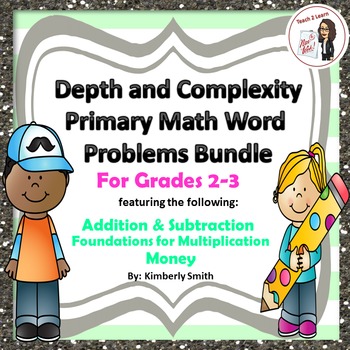Depth & Complexity Primary Math Word Problems Bundle
- PDF
- Easel Activity
What educators are saying
Description
This Depth and Complexity Primary Math Word Problem Bundle includes problems about counting money, addition and subtraction, and the foundations for multiplication. ***Now includes a digital layer! Students get the opportunity to solve real world math problems using the depth and complexity icons and content imperatives to help break down each word problem while also speaking, listening, and writing!
Can Anyone Use Depth & Complexity Frames?
Although these lessons are designed for GATE students, I still use them with my "Non GATE" learners, and they really enjoy it. Using this formatting allows children to really dig down deep into the content. Teachers have the choice of using this as an independent/CGI type activity, an assessment, as a math center, or as a way for kids to work together cooperatively.
If you're a fan of cooperative learning, alternative frames are included which provide different structures embedded into each frame or organizer. This allows kids the opportunity to verbalize their learning and communicate like mathematicians using collaborative conversations.
Writing in Math
Not only will students have a chance to talk about math, but they'll also have to write about it too! Students will need to record information such as important details given in the problem, the academic vocabulary a mathematician might use to discuss the problem, the rules which accompany the math content, and the process in which they went through to get their answer. Additionally, students may have to explain the different ways to solve the problem, how the problem changed over time, or how to prove their answer is correct. There is even a prompt about ethics and making good choices with money.
Differentiate or Add On:
I have included several different template/layout options to use for your preference. You can even use the different layouts to differentiate for your kiddos. Also included is the option to write in the numerical amounts used in the word problems should you want to increase or decrease the numbers given. This also allows you to use each word problem more than once for repeated practice and exposure.
New items included in this bundle which are not part of individual lessons:
+Depth & Complexity/Content Imperative Task Cards- Task cards could be used for collaborative conversations after the problem has been completed or even before the problem has been solved. Allow your students to get up and move by trying out Quiz-Quiz-Trade (directions included) Mix-Pair-Share, or Give One, Get One! Have students at table groups take turns choosing a card for discussion and work as a team to come up with an explanation.
+4 New Prompts- These can be used in addition to the frames (as a back side or as extra worksheets). Students also have the chance to draw the problem out in the space provided to help support conceptual understanding. Give students experience attacking those Common Core Performance Tasks by providing them with time to explain the process they used to answer the question and by responding to two-part questions.
****Detailed 'Suggestions for Use' are also included in this packet as well as an answer key for each problem.
Each of the 3 Lessons Include:
+Depth and Complexity Frames with and without cooperative learning structures embedded
+Instructions for how to use the cooperative learning structures
+ Show the answer 4 ways template
+ Show the answer 3 ways and explain your answer template
+ Alternative formatting for Depth and Complexity Frame which is
made up of boxes
+ Word problem only which leaves more space to work the problem
+ Fill-in-the-blank word problem pages with options to change the numerical values of the problems.
These lessons are also sold separately below.
Depth & Complexity Money Word Problem
Depth & Complexity Operations and Algebraic Thinking: Addition and Subtraction
Depth & Complexity Foundations of Multiplication
Have fun!
If like like this product, you may also be interested in:
Depth & Complexity Math Bundle: Division Fractions Decimals
Depth & Complexity Measurement and Data: Area and Perimeter
Puzzlement Group Investigation Activity Organizer
Adaptations Depth & Complexity Science Frame and Activities
Grammar Bundle: Verbs, Homophones, Multiple Meanings, Plural Nouns, and Adjectives
Spelling Rules Worksheet and Game






